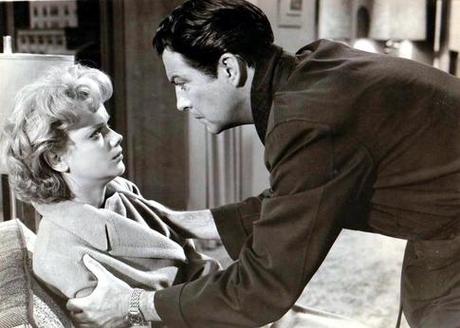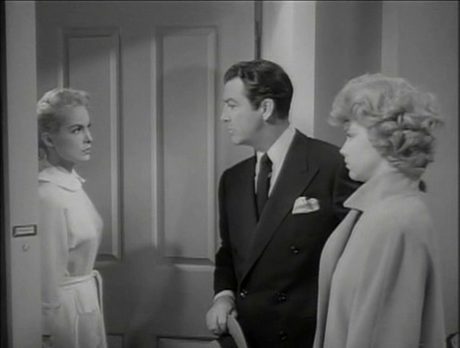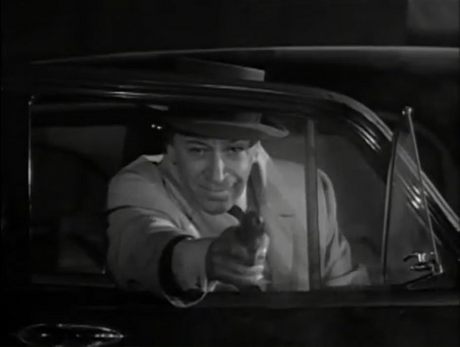
Patterns, connections, trends and interdependence. These are things which draw my attention in general, and in cinema in particular. I'd like to think that visitors to this site have noticed this from time to time, and I'd be even more pleased if I'd managed to pique the interest of some by following up on certain threads that suggest themselves to me. Redemption is the one theme that I guess stands out from the crowd of other ideas, and it's certainly the driving force behind Rogue Cop (1954), which I want to focus on today. I'd also like to touch on what I feel is a defining feature running thorough 1950s cinema as a whole and maybe then cast an eye over the shape and texture of noir at that time. So yes, it ought to be clear enough that I'm setting myself a nice uncomplicated and unambitious task with this one...
Rogue Cop opens in an understated and matter-of-fact manner, with the credits running over a series of background images of cops going about their daily business in the city, making and taking calls, driving squad cars and all seguing into a nighttime scene where the sirens scream and the neon flickers. Throughout this it remains everyday, mundane and routine, even as a showgirl drifts out of the theater where she's been working and makes her way to a penny arcade. Even there the drug deal she's intent on completing is nothing out of the ordinary, nor indeed is the casual filleting of her pusher by a competitor. So there you have it, life and death played out as just another unremarkable event in an overlit and gaudy locale - the whole process as cheap and throwaway as the scene of the crime itself.
Yet, in plot terms, this is more than just another statistic to write up in the records. Chance, that old staple of any self-respecting film noir, steps in and sees to it that the killer who is coolly departing should bump into a young patrolman. This man on the beat is Eddie Kelvaney (Steve Forrest) and while he doesn't make a pinch he does get a good enough look at the knife man to be able to make an identification. Had he not been there at that moment, or had another less ethical man been pounding that particular pavement, the tale would have meandered off in a different direction. But he was there and the fates would also have it that his older brother Chris (Robert Taylor) is a detective with a lot of shady contacts, with the healthy bank balance and unhealthy reputation that brings. Pressure will be brought to bear on Chris to ensure Eddie toes the line and forgets who he saw and where he saw him. Were it only about Chris himself, this would not be a problem; however, Eddie is an idealist and a man who holds firm to the principles of decency his late father lived by, and which his brother professes to regard with contempt. What follows is that age old contest, the battle for the soul of a man with temptation taking place in an urban wasteland with winking lights as opposed to the deserts of antiquity.

Rogue Cop was adapted from a novel by William P McGivern, the man who provided the source material for Fritz Lang's punishing examination of corruption and abusive relationships . Similar to Lang's movie the noir quotient of this production stems as much, and probably more, from the theme as it does from the visuals. While John Seitz shoots the whole thing beautifully and earned himself an Oscar nomination for cinematography, it's not got that painted shadows look that the term film noir so often conjures up. It's got a brighter appearance in general and director Roy Rowland aims for the kind of pared down and uncluttered visual simplicity that Lang had been working on.
Is it possible then that the look here was a reflection of the thematic shift taking place within film noir itself? Noir in the 1940s felt as though it concerned itself primarily with disenchantment and compromised morality on a personal, and thus more intimate, level. Moving into the next decade saw a cleaner and simpler aesthetic gain prominence, which might suggest that thematically it was drifting towards a more sharply defined ethical conundrum. The focus was increasingly on decay in institutional terms, and the ethical deficiencies in broader society. A good deal of the action is situated in flash night clubs and swish apartments, well-lit and with the type of surface gloss that is deceptive - a store-bought glamor that seeks to blind us to the real cheapness, the shabby abuse and exploitation lurking behind it all.
There are those who will tell you a film noir has to have a femme fatale. Personally, I feel she is a common or typical feature but not an essential one, although I do think a strong and pivotal female role in general is vital. Rogue Cop offers two such parts - Janet Leigh's jaded entertainer desperate to escape the sins of the past and, giving a terrific performance, Anne Francis' boozy moll who suffers grievously for a moment's tactlessness. These two are key to the development of the plot and in determining the path Taylor's dirty cop will follow.

Taylor is, right from the beginning, a man trying to save himself, a man hungry for redemption, even if he doesn't realize it till later. The fact remains though that the itch is there, the mask of cynicism barely disguising the intensity of his concern over his brother's welfare. He's only a short step away from acknowledging his desire to find a way out - and that tipping point is achieved first by the fate of his brother, later intensified by the treatment of Francis, and finally confirmed by the constancy of Leigh. It's this spiritual quest that lends weight to the whole movie and lifts it above a mere run-of-the-mill critique of corruption. All of which had me wondering why exactly this theme of redemption is to be seen all through 1950s cinema. I've often written about it here in relation to the western, where it found perhaps its truest expression, but it transcended genre and is almost ubiquitous. Was it a reaction, albeit a delayed one, to the war years? And did it climax at or around the end of the decade? My feeling is that it had - with the closing of the classic noir cycle and the gradual winding down of the golden age of westerns. Still, this is just a feeling on my part and others may be able to offer a more definitive answer.

Of course Rogue Cop, being released in 1954, wasn't coming at the end of any cycle. In fact, it signaled a return for at least one person to bigger pictures than had been the case for a while. That person was George Raft, one of the early stars of the gangster movie whose star slowly faded through the 1940s. I've heard it said - although I'd be happy to be corrected on this if anybody knows different - that Raft at the height of his fame was very choosy about his roles and became very cautious about the image he was projecting on screen. Essentially, he was said to be turning down anything that involved a persona which was less than squeaky clean, something which always struck me as a singularly petty and counterproductive approach. As the chief villain here, Raft is very good indeed, full of malice and vindictiveness. Watching him get this across so successfully had me thinking about the secret of getting under the skin of a villain, of making or becoming a bad man on screen. That demands both self-confidence and humility, it requires that an actor be big enough in his soul to be comfortable playing someone genuinely small and mean of spirit. In short, it needs courage.
Unfortunately, Rogue Cop remains on the missing list as far as official releases on disc are concerned. It is easy enough to watch online in passable condition but it deserves to be available commercially. Whatever is holding that up, it's not the quality of the movie itself. This is a superb 50s film noir with first rate performances all round from an excellent cast, and a solid script which offers plenty of food for thought while simultaneously raising a number of interesting questions.
